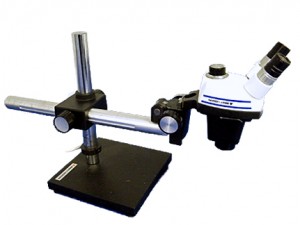
If you are like me, you really hate having to spot prints. You especially do not like spotting negatives. I struggled for years trying to come up with a good way to spot prints. The problem is getting a good look at what you are working on, with enough detail to accurately guide that hair-fine spotting brush to just the right spot. I used a loop. . . tried magnifying glasses. . . used a magnifying viewer for some time, but nothing gave me a really good view of what I was working with.
Somewhere along the way someone suggested using a stereo microscope. What a stroke of genius!
After doing some research it became clear that a high-quality inspection microscope, with magnification in the 8x to 10x range was prefect for spotting both prints and negatives. A good stereo microscope with zoom was exactly what is needed. The ideal setup would have a long boom stand so you can swing the head out over the work area, and for spotting prints you need an illuminator. I was able to find an entire microscope package including a zoom stereo head, eyepieces, long boom stand with heavy base, and illuminator on eBay.
The microscope head that I have has a zoom range of 0.70 to 3.00 x. Using a set of eyepieces that are 10x, I have a zoom range of 7.0 to 30.0 x. This is perfect! Most of the time 7x is fine, but if I have a really tiny pinhole I can zoom in even more. The microscope illuminator is necessary for working with prints, while you will need a light box for working on negatives. This is why you need a good, adjustable, boom with a heavy base.
It takes a little getting used to, but a stereo microscope is the Rolls Royce of spotting magnifiers. Well worth the expense. This type of microscope setup is used in manufacturing quality control to inspect small parts and comes up in the used market frequently. Searching out a good microscope will save you a lot of headaches and make that unpleasant chore of spotting a little more tolerable.
JB